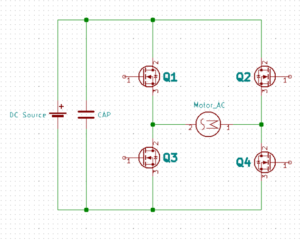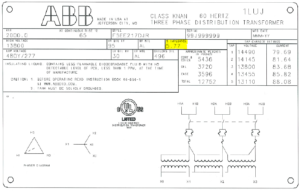What is the Power Factor?
It is the ratio between true power and apparent power. Power factor is a unit-less number used in single  and three-phase AC circuits, it is a measure of how effectively the load draws the real power
and three-phase AC circuits, it is a measure of how effectively the load draws the real power
My favorite analogy to explain this is to use the beer analogy.
The glass represents the capacity of the equipment for example transform, cable, switchgear, etc…
Beer is what we want, the real power, we don’t need the foam when you pay by the glass, you want more beer
What software does DRF engineering utilize for schematics capture and PCB layout?
Before we answer the question, let’s shed light on the terminology. Schematic capture refers to the process of transferring hand-drawn schematic information to a CAD database. For the schematics capture, we use KiCad software. For the PCB layout, we use PADS software by Mentor Graphics.
What are Gerber Files?
Gerber files are the CAD file generated from a PCB design software like KiCad, PADS, Eagle, and Altium that a PCB manufacturer can refer to to build the PCB layer structure.
Why is the inverter tripping off line when powering an appliance in my RV?
What can cause the inverter to trip? One reason that causes the inverter to trip is if the load exceeds the peak current of the inverter, This typically accrued by high inrush current.
What is inrush current? It’s a spike in current that occurs when equipment is powered on. Some appliances are inherently capacitive or inductive load. This will create a high inrush current when powered by an AC supply.
One approach to reducing high inrush current is to use a Thermistor like NTC or PTC.
NTC stands for Negative Temperature Coefficient. Connected in series with the load at switch on, the thermistor’s relatively high cold temperature resistance limits the inrush current. As the current flows, the thermistor heats, reducing its resistance value so that once the initial inrush current has been safely held off, the resistance of the circuit is held at low value to maximize efficiency, other appliances can use this technique including power supply, lighting circuits, electric motors, etc…
What is an inverter?
An inverter is a powerful component that takes a DC input and produces an AC power source. These are commonly used in cars to power AC sources from the car’s DC battery system. It’s also frequently used in reverse, converting AC power to DC for example charging batteries for back power.
How does an inverter work?
At the heart of most inverters, you will find an H-bridge. An H-bridge has four power switches arranged in an H-shape around the load, as shown in Figure 1.

Figure 1: H-bridge topography
When Q1 and Q4 are on, a current is able to flow from left to right across the load. When Q2 and Q3 are on, a current is able to flow from right to left through the load. Thus, a current can flow both ways through the load.
The simplest way an inverter can function is in a cycle: have Q1 and Q4 turn on, followed by Q2 and Q3. It is important to note that the MOSFETs need to turn off before the other power switches can turn on. If both MOSFETs on one side of the inverter are on at the same time, this will cause it to short out. If this switching pattern is followed, a modified sine wave results.
A modified sine wave is the 80-20 solution for power inverters. It requires only about 20% of the effort to produce, yet it performs approximately 80% as well as a perfect sine wave. Still, it’s far from perfect. Many appliances will work at a lower efficiency, as the full power right before and right after a switch gets wasted. Additionally, certain analog devices don’t work quite right with a modified sine wave. Anything using an analog timer doesn’t time correctly since they keep time using the peak of the sine wave, and modified sine waves wreak havoc with temperature control.
What are the Lithium-ion Batteries 18650 safe operating limits
The lifespan of a lithium-ion battery depletes as this threshold is repeatedly crossed and does little to no harm if done once or twice. The battery SHOULD always operate between 3.0V – 4.2V and that is where 95% of its charge remains. The remaining 5% is needed in order for the battery to be able to recharge. If the battery goes below approximately 2.5V, it is almost surely completely dead or its lifespan has dramatically been shortened. When it gets to this range, the battery might never charge again which is why at DRF engineering we use the cut-off 3.0V in our 3.7V nominal voltage lithium-ion single cell.
Normally batteries are physically disconnected from their systems when they approach this threshold in order to limit the amount of parasitic discharge since when a battery will continue to discharge regardless of whether or not it is used in a circuit. For example, if a phone had a 4.2V lithium-ion battery, it would reach 0% charge at 3.0V, and the same applies to other electronics as well.
When a battery passes this cut-off voltage, it begins to decay exponentially.
The other limit is when to stop charging the battery, typically we stop charging at 4.2V, anything beyond this voltage can cause the battery thermal runaway which can cause a fire, This is what happened to Boeing 787 Dreamliners were indefinitely grounded due to lithium-ion battery failures that had occurred in two planes.
Transformer Impedance, is it voltage? what is it?
Every distribution transformer nameplate specifies the transformer impedance in Percent [%], As shown in the drawing below. Why is it not in Ohm?
Actually, this percentage is voltage, and here is the explanation

I personally witnessed many transformers tested in the past, ranging in power from 1MVA to 20MVA for both distribution and transmission.
To measure the transformer impedance, during testing the transformer secondary is shorted. Next, they apply a small percentage of the rated primary voltage to the transformer, the applied voltage starts at 0 volts and gradually they increase the voltage until the winding is magnetized, at this point current will start circulating in the shorted secondary winding. Gradually they continue to increase the primary voltage until the shorted secondary reaches the full load rating of the transformer. When they reach the secondary rated current they stop increasing the primary voltage, They record what percentage of the primary voltage it takes to produce rated secondary current in the shorted out secondary. Actually, that is the percent impedance.
So here is a quiz for you: Are we violating ohm’s law? How is Percent voltage equal to percent impedance?
Would it cost less to buy an off the shelf power supply?
Yes, if you can find an off-the-shelf that meets your system requirement, There is a large variety of power supplies available and it will likely be lower cost than a custom solution. However, if you have a system requirement that is difficult to meet by an off-the-shelf power supply and if you have a large volume. In these cases, there may be cost savings in designing something that precisely meets your needs if you have the engineering resources. Even if an off-the-shelf power supply meets your requirements, the cost may still be high if the off-the-shelf has a limited market and does not enjoy the advantages of economies of scale.
What kind of capabilities does DRF have when it comes to testing? What kind of test capabilities do you provide?
When it comes to product testing….In the past, we have conducted thermal testing, studying the longevity of a product and whether it will endure under exposure to increased temperatures.
Calculators
Busbar Resistance Calculator
Calculate the resistance of a busbar at 20°C, with any given length, width, and height.
Advanced Busbar Resistance Calculator
Calculate the resistance of a busbar at any temperature.
RMS Values of Commonly Observed Converter Waveforms
Calculate the RMS values for any of 10 common waveforms.





